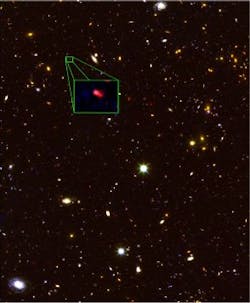Hubble telescope captures images of most known distant galaxy
A collaborative team of astronomers and researchers sifted through more than 100,000 galaxies identified in Hubble Space Telescope images to eventually discover the most distant galaxy ever found, which appears as it was when the universe was only about 5% of its current age.
The Hubble Telescope’s CANDELS survey identified the galaxy, dubbed x8-GND-5296 and created a magnified image from stacks of optical and infrared images taken, respectively, by the Hubble’s Advanced Camera for Survey (ACS), and Wide-Field Camera 3 (WFC).
The Hubble’s ACS camera employs a CCD image detector for use of the near-UV to the near-IR, and a multi-anode microchannel array detector (MAMA) for use in the ultraviolet.
The ACS includes three channels:
- The wide field channel features Scientific Imaging Technologies thinned, backside-illuminated anti-reflection coated CCD image sensors with 15 µm x 15 µm pixel size, a 2 x 2048 x 4096 image format, a field of view of 202 arcseconds x 202 arcseconds, and a spectral response of 3500 Å to 11000 Å.
- The high-resolution channel features the same CCD image sensors, but with 21 µm x 21 µm pixel size, a 1024 x 1024 pixel image format, a field of view of 29 arcseconds x 26 arcseconds, and a spectral response of 1700 Å to 11000 Å.
- The solar blind channel features a Csl microchannel plate with MAMA readout, 25 µm x 25 µm pixel size, a 1024 x 1024 pixel image format, a field of view of 34.6 arcseconds x 30.8 arcseconds, and a spectral response of 1150 Å to 1700 Å.
The Hubble’s WFC, which captured the infrared images of the galaxies in the CANDELS survey, features an ultraviolet and visible light (UVIS) and infrared (IR) channel. A channel select mechanism directs incoming light to the desired channel.
- The IR channel features a Teledyne Imaging Sensor 1Kx1K HgCdTe detector with, a 0.13 arcsecond pixel size, and a total field of view of 123 x 136 arcseconds.
- The UVIS channel features two e2V thinned, backside illuminated, UV-optimized 2Kx4K CCD image sensors with 0.04 arcsecond pixel size and a total field of view of 162 x 162 arcseconds.
Page 1 | Page 2
About the Author

James Carroll
Former VSD Editor James Carroll joined the team 2013. Carroll covered machine vision and imaging from numerous angles, including application stories, industry news, market updates, and new products. In addition to writing and editing articles, Carroll managed the Innovators Awards program and webcasts.

